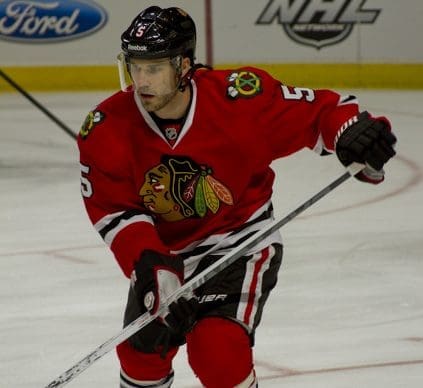NHL
Kingerski: Hockey Concussion Solutions Tainted By Culture, Lawyers

Hockey culture is about conformity and personal responsibility. Players are taught from a young age to follow their coaches, play through pain, and do what is necessary for the team. Hockey culture’s roots are from the best Canadian traditions. And so less than 200 former NHL players have signed on to sue the NHL over post-concussion symptoms. By comparison, over 4000 former players sued the NFL.
It is impossible to compare the number of concussions in the NFL to the NHL because the NHL only recently began reporting them. And sadly, “upper body injury” is still too often used as a substitute. When the league cracked down on obstruction following the 2004-05 lockout, the speed of the game increased dramatically. So too did concussions. It is believed nearly 30 percent of players missed time that season with a head injury, but no proof exists because of secretive reporting by teams and players.
A player who needs stitches to close a wound, has teeth knocked out, suffers a severe bruise or even a broken bone continues to play. With a broken leg, Nick Bonino tried to play in the 2017 Stanley Cup Final.
And we laud them as warriors.
Who knew lasting effects from hits to the head could lead to permanent damage, depression, impaired judgment, personality changes and even suicide? Before the groundbreaking work of Dr. Bennet Omalu, who worked in the Allegheny County Coroner’s office and teamed with colleagues at the University of Pittsburgh to discover chronic traumatic encephalopathy (CTE), we all just assumed the concussion effects would eventually go away. So when Scott Stevens went head hunting, or Matt Cooke rung a bell, we gasped but told ourselves it would all be OK.
It wasn’t OK.
I’ve always favorably compared parts of Canadian culture to the 1940’s and 1950’s U.S. culture. There is camaraderie, national pride, optimism, social manners, yet an agrarian toughness born of rural upbringings. It isn’t so different from Pittsburgh, actually.
So invisible concussions were not treated as injuries. They were treated as headaches or being woozy, but not feared. And here is where two cultures diverge. Sticktap to Rick Westhead’s story on TSN for making the astute point–While Canadians still shoulder responsibility for their own well being, Americans have been taught to protect their rights with lawyers.
For many including this writer, that’s a mind bender but exactly right.
Players don’t want to join the concussion lawsuit because they have been raised and taught to take care of themselves. They don’t believe the NHL was at fault; they think they as players shoulder the blame. And, maybe, there is some truth to that as well. It used to be a consensus among players–“you can hit him in the head but don’t dare hit him in the knees and mess with his career.”
Sidney Crosby’s epic concussion saga which lasted for more than one season and nearly took the game’s best player began to change attitudes and culture. Crosby raised awareness, as did Eric Lindros’ horrific tales of vomiting before games to play through severe concussions. Players began to wake up, but there is still dismissal, deep in hockey’s heart.
And legally, it seems daunting to prove the NHL knew anything about anything. NHL Commissioner Gary Bettman cites a conversation in 2012 with researchers at Boston University. He claims the Boston University team told him directly there was no proof of causality between hockey and CTE. The researchers claim Bettman misstated their conversation.
Currently, Bettman claims there isn’t evidence concussions cause CTE. Unfortunately, he is absolutely correct, but he is threading the needle of semantics. Recent studies have shown concussions are not the cause of CTE–instead, repeated head contact causes CTE. Bettman’s words are true, the spirit of his comments are not.
And so American culture clashes with Canadian culture and both are grappling with the legalese. What seems obvious is not necessarily legally correct. If the estate of former Blackhawks defenseman Steve Montador wins its concussion lawsuit against the league, will more players step forward, or will hockey culture dismiss the victory as an extreme case? Will hockey culture look down on others for hurting the game, if they win their lawsuits?
The difference between football and hockey is that hockey can be played without head contact, even at the NHL level. Body checks are just that and head contact isn’t necessary to maintain hockey physicality.
What we love about hockey is the same attitude which is keeping former players from joining the fight and the same attitude which hasn’t yet led to a ban on all head contact. Therein lays the shame. In the short term, the league’s denials of a CTE-concussion link may save the league and save truckloads of money, but in the long run, an obtuse view will turn even more American children and parents away from the game.
Perhaps the pervasive individual responsibility views will finally solve the problem quietly and without fanfare. Maybe players will steadfastly enforce an unwritten “no hits to the head” policy as they do hits to the knees. Or, perhaps lawyers will need to solve this issue for everyone.
As cultures collide, not even the “right thing” is a sure thing. And the NHL legal team is exploiting that open ice. Maybe fan shaming of Tom Wilson’s hit on Zach Aston-Reese and a fan rejection of such players are the push NHL organizations need. It can’t hurt. Until then, what is right, what is legal, and who is to blame is an unanswered question caught in the clash of culture.












